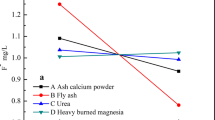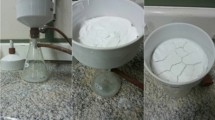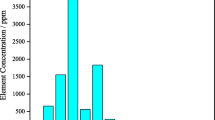Abstract
Phosphogypsum (PG) is an industrial by-product of the transformation of phosphate rocks. For decades, PG has been a source of environmental concern due to the massive amount produced thus far, i.e., 7 billion tons, with a current production rate of 200–280 million tons per year. Phosphate minerals contain various impurities that precipitate and concentrate within PG. These impurities hinder PG usability in various sectors. This paper aims to purify PG using an innovative process based on staged valorization of PG. Initially, PG dissociation by ethylenediaminetetraacetic acid (EDTA) was optimized. After screening of different parameters and monitoring the ionic conductivity of solutions, it was disclosed that a pH-dependent solubilization process in the presence of EDTA resulted in high solubility of PG, up to 11.82 g/100 mL at pH > 11. Subsequently, a recovery of the purified PG by selective precipitation of calcium sulfate dihydrate (CSD) from obtained filtrate through pH adjustment to 3.5 were investigated. An abatement of 99.34% Cr, 97.15% Cd, 95.73% P2O5, 92.75% Cu, 92.38% Al2O3, 91.16% Ni, 74.58% Zn, 72.75% F, 61.43% MgO, 58.8% Fe2O3, 56.97% K2O, and 55.41% Ba was achieved. The process relied on the variation of EDTA chelation properties towards monovalent, divalent, and trivalent cations at different pHs. According to the findings of this study, a staged purification process in the presence of EDTA is an effective method for removing impurities from the industrial PG.









Similar content being viewed by others
Data availability
All data are included within the manuscript and its supplementary material.
References
Al-Hwaiti MS (2015) Assessment of the radiological impacts of treated phosphogypsum used as the main constituent of building materials in Jordan. Environ Earth Sci 74:3159–3169. https://doi.org/10.1007/s12665-015-4354-2
Al-Khaldi MH, Al-Juhani AM, Al-Mutairi SH, Gurmen MN (2011) New Insights into the removal of calcium sulfate scale. In: All days. SPE, Noordwijk, The Netherlands, p SPE-144158-MS. https://doi.org/10.2118/144158-MS
Al-Masri MS, Amin Y, Ibrahim S, Al-Bich F (2004) Distribution of some trace metals in Syrian phosphogypsum. Appl Geochem 19:747–753. https://doi.org/10.1016/j.apgeochem.2003.09.014
Al-Thyabat S, Zhang P (2015) REE extraction from phosphoric acid, phosphoric acid sludge, and phosphogypsum. Miner Process Extr Metall 124:143–150. https://doi.org/10.1179/1743285515Y.0000000002
Andrade Neto JS, Bersch JD, Silva TSM et al (2021) Influence of phosphogypsum purification with lime on the properties of cementitious matrices with and without plasticizer. Constr Build Mater 299:123935. https://doi.org/10.1016/j.conbuildmat.2021.123935
Bensalah H, Bekheet MF, AlamiYounssi S et al (2018) Hydrothermal synthesis of nanocrystalline hydroxyapatite from phosphogypsum waste. J Environ Chem Eng 6:1347–1352. https://doi.org/10.1016/j.jece.2018.01.052
Blengini GA, Latunussa CEL, Eynard U, Torres de Matos C, WittmerD, Georgitzikis K, Pavel C, Carrara S, Mancini L, Unguru M,Blagoeva D, Mathieux F, Penning D (2020) Study on the EU’s list of critical raw materials – final report, European Commission, Directorate-General for Internal Market, Industry, Entrepreneurship and SMEs, Publications Office of the European Union, Luxembourg. https://doi.org/10.2873/11619
Bodine MW (1973) Edta dissolution of gypsum, anhydrite, and Ca-Mg carbonates. J Sedimentary Petrol 43:5
Boija S, Almesåker A, Hedenström E et al (2014) Determination of conditional stability constants for some divalent transition metal ion-EDTA complexes by electrospray ionization mass spectrometry. J Mass Spectrom 49:550–556. https://doi.org/10.1002/jms.3372
Bounaga A, Alsanea A, Lyamlouli K et al (2022) Microbial transformations by sulfur bacteria can recover value from phosphogypsum: a global problem and a possible solution. Biotechnol Adv 57:107949. https://doi.org/10.1016/j.biotechadv.2022.107949
Bumanis G, Zorica J, Bajare D, Korjakins A (2018) Technological properties of phosphogypsum binder obtained from fertilizer production waste. Energy Procedia 147:301–308. https://doi.org/10.1016/j.egypro.2018.07.096
Burns JR, Cargill JG (1987) Kinetics of dissolution of calcium oxalate calculi with calcium-chelating irrigating solutions. J Urol 137:530–533. https://doi.org/10.1016/S0022-5347(17)44100-0
Calderón-Morales BRS, García-Martínez A, Pineda P, García-Tenório R (2021) Valorization of phosphogypsum in cement-based materials: limits and potential in eco-efficient construction. J Build Eng 44:102506. https://doi.org/10.1016/j.jobe.2021.102506
Cánovas CR, Chapron S, Arrachart G, Pellet-Rostaing S (2019) Leaching of rare earth elements (REEs) and impurities from phosphogypsum: a preliminary insight for further recovery of critical raw materials. J Clean Prod 219:225–235. https://doi.org/10.1016/j.jclepro.2019.02.104
Cao Y, Cui Y, Yu X et al (2021) Bibliometric analysis of phosphogypsum research from 1990 to 2020 based on literatures and patents. Environ Sci Pollut Res 28:66845–66857. https://doi.org/10.1007/s11356-021-15237-y
Chen X, Gao J, Liu C, Zhao Y (2018) Effect of neutralization on the setting and hardening characters of hemihydrate phosphogypsum plaster. Constr Build Mater 190:53–64. https://doi.org/10.1016/j.conbuildmat.2018.09.095
Chen Y, Jiang H, Li Y et al (2022) A critical review on EDTA washing in soil remediation for potentially toxic elements (PTEs) pollutants. Rev Environ Sci Biotechnol 21:399–423. https://doi.org/10.1007/s11157-022-09613-4
Chernysh Y, Yakhnenko O, Chubur V, Roubík H (2021) Phosphogypsum recycling: a review of environmental issues, current trends, and prospects. Appl Sci 11:1575. https://doi.org/10.3390/app11041575
Chouaya S, Abbassi MA, Younes RB, Abderafi S (2019) Use of phosphogypsum-tar based material in the manufacture of building products. J Mater Environ 10:1391
Diwa RR, Tabora EU, Palattao BL et al (2022) Evaluating radiation risks and resource opportunities associated with phosphogypsum in the Philippines. J Radioanal Nucl Chem 331:967–974. https://doi.org/10.1007/s10967-021-08142-8
Dong Z, Sun Q, Ranjith PG (2019) Surface properties of grayish-yellow sandstone after thermal shock. Environ Earth Sci 78:420. https://doi.org/10.1007/s12665-019-8451-5
Du M, Wang J, Dong F et al (2022) The study on the effect of flotation purification on the performance of α-hemihydrate gypsum prepared from phosphogypsum. Sci Rep 12:95. https://doi.org/10.1038/s41598-021-04122-w
El Issiouy S, Atbir A, Mançour-Billah S et al (2013) Thermal treatment of moroccan phosphogypsum. MATEC Web of Conferences 3:01030. https://doi.org/10.1051/matecconf/20130301030
El Zrelli R, Rabaoui L, Daghbouj N et al (2018) Characterization of phosphate rock and phosphogypsum from Gabes phosphate fertilizer factories (SE Tunisia): high mining potential and implications for environmental protection. Environ Sci Pollut Res 25:14690–14702. https://doi.org/10.1007/s11356-018-1648-4
Ennaciri Y, Bettach M (2018) Procedure to convert phosphogypsum waste into valuable products. Mater Manuf Processes 33:1727–1733. https://doi.org/10.1080/10426914.2018.1476763
Er-ramly A, Ider A (2016) Physicochemical and mineralogical characterization of Moroccan clay of Taza and Its use in ceramic technology. https://doi.org/10.11648/j.nano.20160402.12
Fang L, Li J, Donatello S et al (2018) Recovery of phosphorus from incinerated sewage sludge ash by combined two-step extraction and selective precipitation. Chem Eng J 348:74–83. https://doi.org/10.1016/j.cej.2018.04.201
Felfoul HS, Ouertani N, Clastres P, Benouezdou M (2002) Amélioration des caractéristiques du phosphogypse en vue de son utilisation en technique routière. Environnement, Ingénierie & Développement N°28–4ème Trimestre 2002:21. https://doi.org/10.4267/dechets-sciences-techniques.2405
Fuleihan NF (2012) Phosphogypsum Disposal-The Pros & Cons of Wet Versus Dry Stacking. Procedia Engineering 46:195–205. https://doi.org/10.1016/j.proeng.2012.09.465
Gasser MS, Ismail ZH, Abu Elgoud EM et al (2019) Process for lanthanides-Y leaching from phosphogypsum fertilizers using weak acids. J Hazard Mater 378:120762. https://doi.org/10.1016/j.jhazmat.2019.120762
Guangfei Q, Heng Li, Ping N, Haishan D (2020) Method and device for removing impurities in phosphogypsum by high gradient magnetic field. China Patent No 110(918):251
Guerrero JL, Gutiérrez-Álvarez I, Mosqueda F et al (2019) Pollution evaluation on the salt-marshes under the phosphogypsum stacks of Huelva due to deep leachates. Chemosphere 230:219–229. https://doi.org/10.1016/j.chemosphere.2019.04.212
Hammas I, Horchani-Naifer K, Férid M (2013) Solubility study and valorization of phosphogypsum salt solution. Int J Miner Process 123:87–93. https://doi.org/10.1016/j.minpro.2013.05.008
Hammas-Nasri I, Elgharbi S, Ferhi M et al (2020) Investigation of phosphogypsum valorization by the integration of the Merseburg method. New J Chem 44:8010–8017. https://doi.org/10.1039/D0NJ00387E
Haneklaus N, Barbossa S, Basallote MD et al (2022) Closing the upcoming EU gypsum gap with phosphogypsum. Resour Conserv Recycl 182:106328. https://doi.org/10.1016/j.resconrec.2022.106328
Harris DC, Lucy CA (2020) Solutions Manual for Quantitative Chemical Analysis, Tenth edition. W. H. Freeman, Austin, Boston, New York, Plymouth
Hou S, Zou Y, Liu X et al (2011) CaF2 and CaF2:Ln3+ (Ln = Er, Nd, Yb) hierarchical nanoflowers: hydrothermal synthesis and luminescent properties. CrystEngComm 13:835–840. https://doi.org/10.1039/C0CE00396D
Huang Y, Qian J, Kang X et al (2019) Belite-calcium sulfoaluminate cement prepared with phosphogypsum: Influence of P2O5 and F on the clinker formation and cement performances. Constr Build Mater 203:432–442. https://doi.org/10.1016/j.conbuildmat.2019.01.112
Jagoda Z, Pelczarska A, Szczygieł I (2018) Model studies on the separation of Ca2+ and Nd3+ ions using ethylenediaminetetraacetic acid. J Therm Anal Calorim 133:391–397. https://doi.org/10.1007/s10973-017-6822-2
Khaless K, Chanouri H, Amal S et al (2022) Wet Process Phosphoric Acid Purification Using Functionalized Organic Nanofiltration Membrane. Separations 9:100. https://doi.org/10.3390/separations9040100
Khaless, K. and Dhiba, D., OCP SA, 2020. Process for producing sodium sulphate from phosphogypsum. U.S. Patent 10,689,261.
Lanigan RS, Yamarik TA (2002) Final Report on the Safety Assessment of EDTA, Calcium Disodium EDTA, Diammonium EDTA, Dipotassium EDTA, Disodium EDTA, TEA-EDTA, Tetrasodium EDTA, Tripotassium EDTA, Trisodium EDTA, HEDTA, and Trisodium HEDTA. Int J Toxicol 21:95–142. https://doi.org/10.1080/10915810290096522
Li X, Zhang Q (2021) Dehydration behaviour and impurity change of phosphogypsum during calcination. Constr Build Mater 311:125328. https://doi.org/10.1016/j.conbuildmat.2021.125328
Li J, Peng X, Zheng J et al (2022) Simultaneous removal of phosphorus and organic contaminants from phosphogypsum using hydrothermal method for gypsum resource regeneration. J Environ Chem Eng 10:108441. https://doi.org/10.1016/j.jece.2022.108441
Liu J, Li K, Wang H et al (2004) Rapid formation of hydroxyapatite nanostructures by microwave irradiation. Chem Phys Lett 396:429–432. https://doi.org/10.1016/j.cplett.2004.08.094
Liu S, Ouyang J, Ren J (2020) Mechanism of calcination modification of phosphogypsum and its effect on the hydration properties of phosphogypsum-based supersulfated cement. Constr Build Mater 243:118226. https://doi.org/10.1016/j.conbuildmat.2020.118226
Liu X, Wu F, Qu G et al (2022) Application prospect of advanced oxidation technology in wet process phosphoric acid production. J Environ Chem Eng 10:108868. https://doi.org/10.1016/j.jece.2022.108868
Liu Y, Chen Q, Dalconi MC et al (2022) Retention of phosphorus and fluorine in phosphogypsum for cemented paste backfill: Experimental and numerical simulation studies. Environ Res 214:113775. https://doi.org/10.1016/j.envres.2022.113775
Liu X, Zhang Y, Cheng M et al (2023) Recycling phosphorus from waste in China: Recycling methods and their environmental and resource consequences. Resour Conserv Recycl 188:106669. https://doi.org/10.1016/j.resconrec.2022.106669
López FA, Tayibi H, García-Díaz I, Alguacil FJ (2015) Thermal dehydration kinetics of phosphogypsum. Mater Construcc 65:e061. https://doi.org/10.3989/mc.2015.07214
Meng M, Luo W, Wang S, Zeng G (2022) Predicting the leachate generation from wet phosphogypsum stack using a water-balance-analysis based model. Environ Res 212:113338. https://doi.org/10.1016/j.envres.2022.113338
Nasrellah H, Yassine I, Hatimi B, Joudi M, Chemaa A, El Gaini L, Hatim Z, El Mhammedi MA, Bakasse M (2017) New synthesis of hydroxyapatite from local phosphogypsum. J Mater Environ Sci 8:3168–3174
Pan Z, Zeng B, Yu G et al (2022) Mechanistic insights into Ca-alginate gel-associated membrane fouling affected by ethylene diamine tetraacetic acid (EDTA). Sci Total Environ 842:156912. https://doi.org/10.1016/j.scitotenv.2022.156912
Papanicolaou F, Antoniou S, Pashalidis I (2009) Experimental and theoretical studies on physico-chemical parameters affecting the solubility of phosphogypsum. J Environ Radioact 100:854–857. https://doi.org/10.1016/j.jenvrad.2009.06.012
Parreira AB, Kobayashi ARK, Silvestre OB (2003) Influence of Portland Cement Type on Unconfined Compressive Strength and Linear Expansion of Cement-Stabilized Phosphogypsum. J Environ Eng 129:956–960. https://doi.org/10.1061/(ASCE)0733-9372(2003)129:10(956)
Popek E (2018) Chapter 4 - Practical Approach to Sampling. In: Popek E (ed) Sampling and Analysis of Environmental Chemical Pollutants (Second Edition). Elsevier, pp 145–225
Rashad AM (2017) Phosphogypsum as a construction material. J Clean Prod 166:732–743. https://doi.org/10.1016/j.jclepro.2017.08.049
SfarFelfoul H, Ouertani N, Clastres P, Benouezdou M (2002) Amélioration des caractéristiques du phosphogypse en vue de son utilisation en technique routière. Déchets, Sciences Et Techniques. https://doi.org/10.4267/dechets-sciences-techniques.2405
Shen Y-J, Zhang Y-L, Gao F et al (2018) Influence of Temperature on the Microstructure Deterioration of Sandstone. Energies 11:1753. https://doi.org/10.3390/en11071753
Silva LFO, Oliveira MLS, Crissien TJ et al (2022) A review on the environmental impact of phosphogypsum and potential health impacts through the release of nanoparticles. Chemosphere 286:131513. https://doi.org/10.1016/j.chemosphere.2021.131513
Singh M (2002) Treating waste phosphogypsum for cement and plaster manufacture. Cem Concr Res 32:1033–1038. https://doi.org/10.1016/S0008-8846(02)00723-8
Singh M, Garg M, Rehsi SS (1993) Purifying phosphogypsum for cement manufacture. Constr Build Mater 7:3–7. https://doi.org/10.1016/0950-0618(93)90018-8
Singh M, Garg M, Verma CL et al (1996) An improved process for the purification of phosphogypsum. Constr Build Mater 10:597–600. https://doi.org/10.1016/S0950-0618(96)00019-0
Sun M, Sun Q, Zhang J, Sheng J (2022) Surface modification of phosphogypsum and application in polyolefin composites. Environ Sci Pollut Res 29:66177–66190. https://doi.org/10.1007/s11356-022-20414-8
Sunda W, Huntsman S (2003) Effect of pH, light, and temperature on Fe–EDTA chelation and Fe hydrolysis in seawater. Mar Chem 84:35–47. https://doi.org/10.1016/S0304-4203(03)00101-4
Taciroğlu MV, Ergezer F, Baykal T et al (2022) Investigation of waste quartz sand as filler in hot-mix asphalt. Constr Build Mater 342:128004. https://doi.org/10.1016/j.conbuildmat.2022.128004
Tayibi H, Choura M, López FA et al (2009) Environmental impact and management of phosphogypsum. J Environ Manage 90:2377–2386. https://doi.org/10.1016/j.jenvman.2009.03.007
Tian J, Xu L, Sun W et al (2019) The selective flotation separation of celestite from fluorite and calcite using a novel depressant EDTA. Powder Technol 352:62–71. https://doi.org/10.1016/j.powtec.2019.04.051
Walawalkar M, Nichol CK, Azimi G (2016) Process investigation of the acid leaching of rare earth elements from phosphogypsum using HCl, HNO3, and H2SO4. Hydrometallurgy 166:195–204. https://doi.org/10.1016/j.hydromet.2016.06.008
Wang Z, Huang C, Wang J, Zou B (2019) Development of a novel aqueous hydroxyapatite suspension for stereolithography applied to bone tissue engineering. Ceram Int 45:3902–3909. https://doi.org/10.1016/j.ceramint.2018.11.063
Wang B, Yang L, Luo T, Cao J (2021) Study on the Kinetics of Hydration Transformation from Hemihydrate Phosphogypsum to Dihydrate Phosphogypsum in Simulated Wet Process Phosphoric Acid. ACS Omega 6:7342–7350. https://doi.org/10.1021/acsomega.0c05432
Wang C, Xiong D, Chen Y et al (2022) Characteristic pollutant purification analysis of modified phosphogypsum comprehensive utilization. Environ Sci Pollut Res 29:67456–67465. https://doi.org/10.1007/s11356-022-22737-y
Wei Z, Deng Z (2022) Research hotspots and trends of comprehensive utilization of phosphogypsum: bibliometric analysis. J Environ Radioactivity 242:106778. https://doi.org/10.1016/j.jenvrad.2021.106778
Weiksnar KD, Clavier KA, Robey NM, Townsend TG (2022) Changes in trace metal concentrations throughout the phosphogypsum lifecycle. Sci Total Environ 851:158163. https://doi.org/10.1016/j.scitotenv.2022.158163
Wu F, Ren Y, Qu G et al (2022) Utilization path of bulk industrial solid waste: A review on the multi-directional resource utilization path of phosphogypsum. J Environ Manag 313:114957. https://doi.org/10.1016/j.jenvman.2022.114957
Wu F, Zhao C, Qu G et al (2022) A critical review of the typical by-product clean ecology links in the Chinese phosphorus chemical industry in China: Production technologies, fates and future directions. J Environ Chem Eng 10:106685. https://doi.org/10.1016/j.jece.2021.106685
Xie CZ (2009) Environmental Impacts of Effluent Containing EDTA from Dairy Processing Plants. The University of Waikato, Thesis
Xie R, Feng Z, Li S, Xu B (2011) EDTA-Assisted Self-Assembly of Fluoride-Substituted Hydroxyapatite Coating on Enamel Substrate. Cryst Growth Des 11:5206–5214. https://doi.org/10.1021/cg101708y
Xin R, Ren F, Leng Y (2010) Synthesis and characterization of nano-crystalline calcium phosphates with EDTA-assisted hydrothermal method. Mater Des 31:1691–1694. https://doi.org/10.1016/j.matdes.2009.01.048
Yahorava V, Lakay E, Clark W, Strauss J (2018) Hydrothermal Modification of Phosphogypsum to Improve Subsequent Recovery of Rare Earths. In: Davis BR, Moats MS, Wang S, et al. (eds) Extraction 2018. Springer International Publishing, Cham, pp 2415–2427. https://doi.org/10.1007/978-3-319-95022-8_204
Yang J, Liu W, Zhang L, Xiao B (2009) Preparation of load-bearing building materials from autoclaved phosphogypsum. Constr Build Mater 23:687–693. https://doi.org/10.1016/j.conbuildmat.2008.02.011
Yang L, Zhang Y, Yan Y (2016) Utilization of original phosphogypsum as raw material for the preparation of self-leveling mortar. J Clean Prod 127:204–213. https://doi.org/10.1016/j.jclepro.2016.04.054
Zhang P (2014) Comprehensive Recovery and Sustainable Development of Phosphate Resources. Procedia Eng 83:37–51. https://doi.org/10.1016/j.proeng.2014.09.010
Zhang K, Dai Z, Zhang W et al (2021) EDTA-based adsorbents for the removal of metal ions in wastewater. Coord Chem Revs 434:213809. https://doi.org/10.1016/j.ccr.2021.213809
Zhang H, Chai W, Cao Y (2022) Flotation separation of quartz from gypsum using benzyl quaternary ammonium salt as collector. Appl Surf Sci 576:151834. https://doi.org/10.1016/j.apsusc.2021.151834
Funding
This work was supported by the Foundation OCP [grant numbers AS15]; and Mohammed VI Polytechnic University (UM6P).
Author information
Authors and Affiliations
Contributions
All authors contributed to the study conception and design. Conceptualization, investigation, methodology, formal analysis, writing (original draft), writing (review and editing), visualization, and validation were performed by Hamza CHANOURI. Formal analysis, analysis and characterization, investigation, and validation were performed by Khalid AGAYR. Resources, analysis and characterization, funding acquisition, and project administration were performed by El Mahdi Mounir. Supervision, funding acquisition, project administration, and writing (review and editing) were performed by Rachid BENHIDA. Conceptualization, supervision, funding acquisition, project administration, resources, and writing (review and editing) were performed by Khaoula KHALESS. The first draft of the manuscript was written by Hamza CHANOURI, and all authors commented on previous versions of the manuscript. All authors read and approved the final manuscript.
Corresponding author
Ethics declarations
Ethical approval
Not applicable.
Consent to participate
All authors have read this manuscript and consent for publication in Environmental Science and Pollution Research.
Consent to publish
Not applicable.
Competing interests
The authors declare no competing interests.
Additional information
Responsible Editor: Guilherme L. Dotto
Publisher's note
Springer Nature remains neutral with regard to jurisdictional claims in published maps and institutional affiliations.
Rights and permissions
Springer Nature or its licensor (e.g. a society or other partner) holds exclusive rights to this article under a publishing agreement with the author(s) or other rightsholder(s); author self-archiving of the accepted manuscript version of this article is solely governed by the terms of such publishing agreement and applicable law.
About this article
Cite this article
Chanouri, H., Agayr, K., Mounir, E.M. et al. Staged purification of phosphogypsum using pH-dependent separation process. Environ Sci Pollut Res 31, 9920–9934 (2024). https://doi.org/10.1007/s11356-023-26199-8
Received:
Accepted:
Published:
Issue Date:
DOI: https://doi.org/10.1007/s11356-023-26199-8




